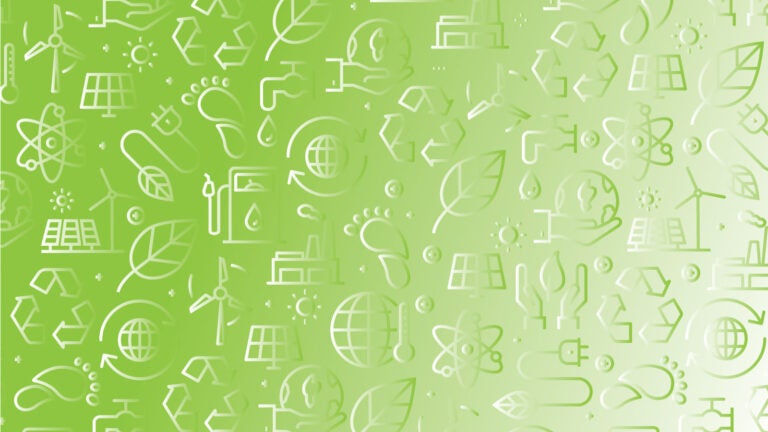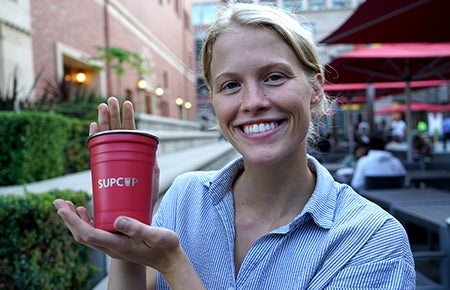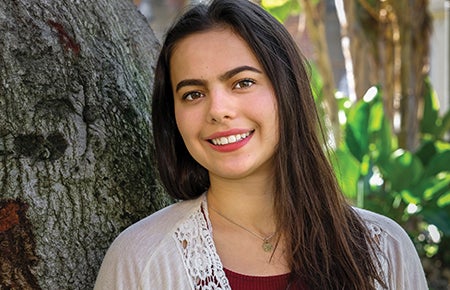
Between classes, USC Dornsife students fight climate change
With climate change and pollution threatening life on Earth, students at the USC Dornsife College of Letters, Arts and Sciences aren’t waiting for others to come up with solutions. These five students are working on their degrees — and working on ways to reduce environmental damage.

Daphne Armstrong (Photo: Krystal Gallegos/Daily Trojan.)
Party On, Planet
Red Solo cups are ubiquitous across college campuses — and landfills. Made from a nonrecyclable polystyrene that takes nearly 500 years to decompose, the disposable cups are tossed into the garbage after every tailgate gathering. Senior Daphne Armstrong, a psychology and public policy double major who has been taking classes on climate change, knew there could be a better way. She formed a startup, SUPCUP, and created a reusable version of the cup that lets you party guilt-free. She’s already sold 400, including a set to fellow USC Dornsife student William Koch, an international relations major, who purchased them for the Delta Phi Epsilon fraternity. Read more about Daphne >>

Juan Pablo de los Rios (Photo: Mike Glier)
Sea of Love
The Great Pacific Garbage Patch consists of 900,000 tons of plastic. Its days might be numbered though, thanks to USC Dornsife student Juan Pablo de los Rios. A chemistry graduate student in Gabilan Assistant Professor of Chemistry Megan Fieser’s lab, he’s experimenting with ways to create new polymers that are similar to plastic but which also biodegrade — which could mean fewer plastic forks and bags and more aquatic life in our oceans in the future. Read more about Juan Pablo’s work >>

Lorena Hong (Photo: Rhonda Hillbery)
She’s Walking on Sunshine
For chemistry major Lorena Hong, coursework is about more than just grades. Each week, she spends 10 to 12 hours in Assistant Professor of Chemistry Smaranda Marinescu’s lab researching methods to store solar energy. “Since we’re eventually going to run out of fossil fuels, we need to look at sources of renewable energy, and solar energy is one of the most promising,” said Hong. Her work, with graduate student mentor Nicholas Orchanian, contributed to a peer-reviewed paper published in Applied Energy Materials last December. Read a profile of Lorena >>

Yao Lu (Photo: Rhonda Hillbery)
Cooking Up a Solution
Not content to solve one problem, Yao Lu, a chemistry postdoc, is tackling two. His startup Catapower Inc. is turning used cooking oil into lactate as well as a renewable fuel. Lactate, a natural biodegradable polymer, can be used in products like cosmetics while his biodiesel is made much more affordably than traditional methods. The world of the future could see trucks fueled by his biodiesel delivering products made with Catapower lactate, all stemming from the oil that cooked up your lunch. Read a profile of Yao Lu >>

Kayla Soren (Photo: Gus Ruelas)
We Are the World
While growing up in Louisville, Kentucky, environmental studies and international relations major Kayla Soren would hike the lush Appalachian Mountains with her family. Over time, however, as more and more bulldozers razed the land for coal mining, it became almost impossible to find the trails they loved to hike. This experience led her to found the International Student Environmental Coalition, which empowers students around the globe to tackle climate change. She was recently rewarded a prestigious Truman scholarship in recognition of this work. Read a profile of Kayla Soren >>